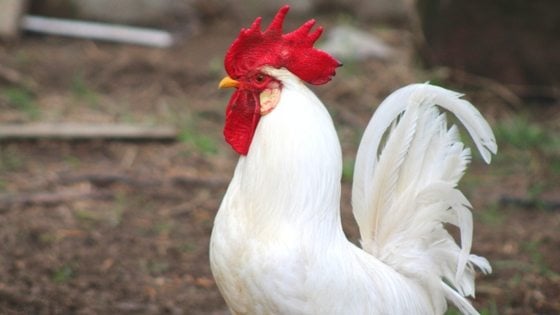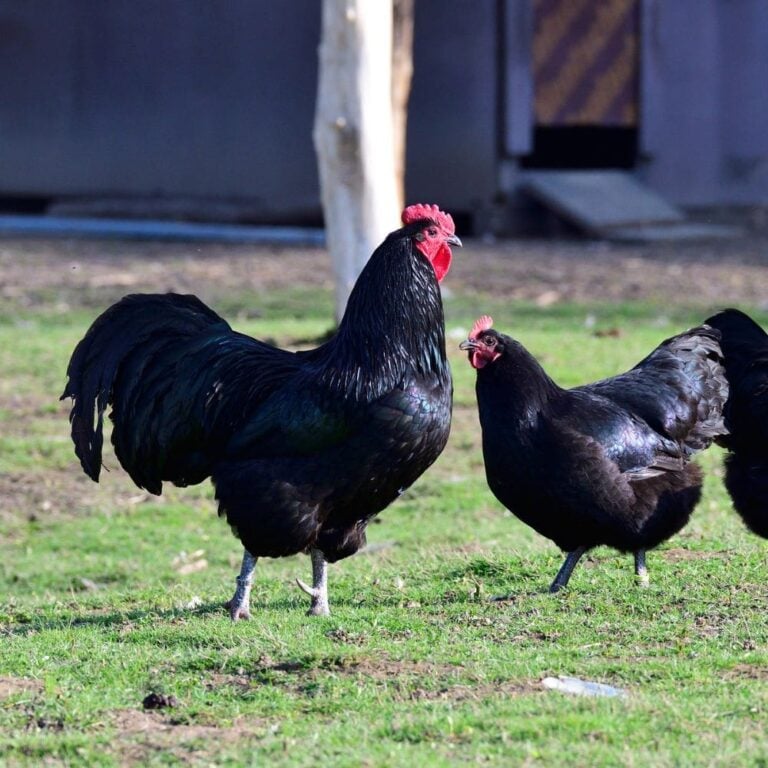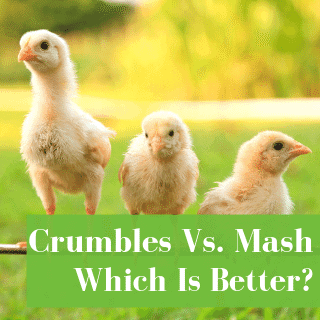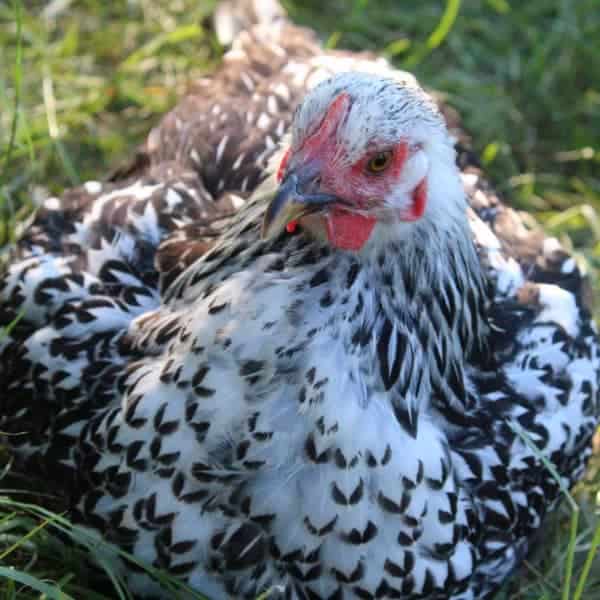If you want a truly beautiful hen in your flock, you can’t go wrong with a Wyandotte chicken. With their intricately laced feathers and easy-going personalities, they’re the perfect addition to any backyard flock.
We have a few of these hens in our coop, and they not only are fun to look at, but they also lay large brown eggs. I fondly remember my very first Wyandotte, such an amazing chicken.
We’ve also hatched a few chicks – and even the barnyard mixes (aka mutts) had the delicate laced pattern on their feathers.
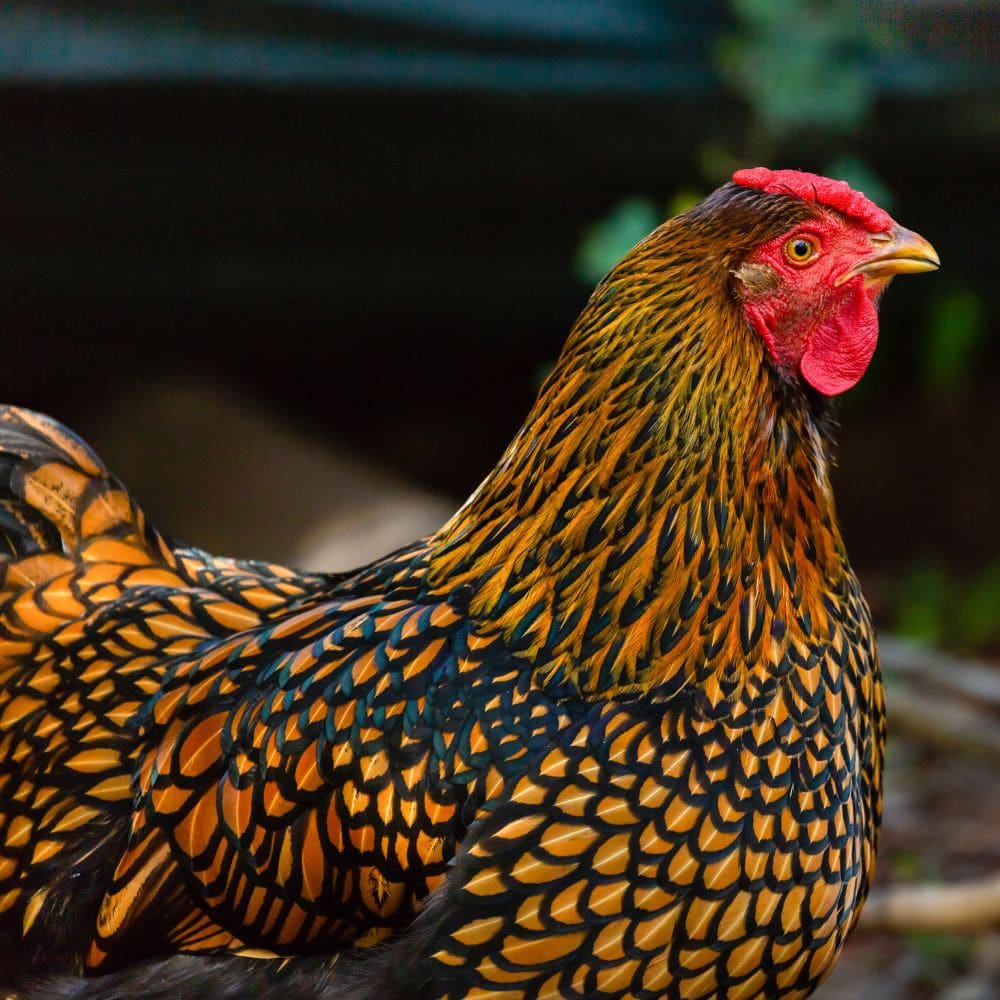
In this article, you’ll discover everything you need to know about Wyandotte chickens, including:
- How to feed them
- The different varieties
- What their personalities are like
- Where to buy them
Buckle up and get ready to be WOWED by the Wyandotte!
Table of Contents (Quickly Jump To Information)
Wyandotte Chicken Personalities
Are Wyandotte Chickens Friendly?
Yes! These chickens are friendly birds and they love to interact with humans. It’s always best to spend time with your flock when they’re chicks so they learn to recognize you as their friend – as they grow into adults, they’ll enjoy spending time with you more.
Throw them some treats (that happen to be very healthy) and they will come running whenever they see you, I promise. These are my favorites.
The roosters aren’t aggressive, and the hens don’t “go broody” – and they’re always cheerful! If they do happen to go broody, and you let them, they do make great mothers. All in all, they make great pets! You can learn more about how to raise friendly chickens here.
In a flock, they get along with other chickens. Wyandotte chickens are bred to be friendly and docile so they typically aren’t bullies and will easily fit into most backyard flocks without drama.
All this to say, this breed gets an A in the temperament category and makes amazing beginner-friendly chickens.
Are Wyandottes Aggressive?
Not normally. When the roosters are about 1 year old, they occasionally can become a bit aggressive as they “feel their oats” and the hormones kick in. However, like most roosters, they’ll mellow out after the first year.
The hens are always friendly, and since they don’t usually go broody, you can expect them to not undergo any personality changes during breeding season (spring and summer).
All About Wyandotte Chicken Eggs
Wyandotte chicken egg color: Light brown or cream
Wyandottes are great at egg laying so you’ll enjoy about 280 brown eggs a year. If you add plenty of shavings and herbs to her nesting box – and offer high protein treats and calcium – your flock will bless you with breakfast about 4 times a week!
They are known for being pretty productive egg layers in the winter months as well.
If you notice your Wyandotte laying egg shells that are weak (meaning, they break easily), offer her more oyster shells to increase her calcium intake.
How Big Are Wyandotte Eggs?
Wyandottes are medium-sized chickens (about the size of a Buff Orpington, but smaller than a Jersey Giant), but they lay nice large eggs. Unlike bantams, you can expect a Wyandotte’s egg to be the same size as a grocery store egg – but since you can feed your chickens a healthy diet, her eggs will probably be better than store-bought!
What Color Eggs Do Silver-Laced Wyandotte Chickens Lay?
Silver Laced Wyandotte egg color: Light brown or cream colored.
Silver Laced Wyandotte chickens lay large, light-brown eggs. Some would call the color of her eggs a “cream” or “latte” color – either way, they’re large enough to make a nice omelet AND they look beautiful! (Note that the golden laced wyandotte egg color is the same – a light brown or cream color).
Are Columbian Wyandotte Good Egg Layers?
Like all other Wyandotte chickens, the Columbian variety is a great layer of light brown eggs.
How Long Do Wyandotte Chickens Lay Eggs?
Wyandotte chickens will likely give you eggs until about 3 years old. Most hens lay consistently from 9 months old until about 3 years old. After 3 years, she might still produce eggs, but it’ll probably be less frequent. However, there are some champion layers who will consistently give you eggs their whole life.
To keep your hen in good shape, it’s best to feed her a diet of 16% protein layer feed and also offer high protein treats and lots of calcium.
How Old Are Wyandottes When They Start Laying?
The Wyandotte chicken usually starts laying eggs at 6 months old. The exception is if they turn 6 months in the dead of winter – then she might not start laying until the following spring.
Most chickens need about 14 hours of light per day to start laying – without it, they don’t produce the necessary hormones. You might be able to prompt laying by adding a light to their coop and giving them some extra light before nightfall.
Do Wyandotte Chickens Go Broody?
Like any other chicken breed, it’ll depend on the individual chicken. On the whole, Wyandottes don’t go broody (meaning the hen wants to hatch eggs for chicks). Instead, they prefer to spend their time looking for bugs and other goodies in the dirt.
If you want chicks from your hens, it’s probably best to incubate them. You can see the list of incubators we recommend here.
Wyandotte Chickens Breed Standard of Perfection
What do Wyandotte Chickens Look Like?
According to the Laced Wyandotte Club, this breed should sport these characteristics:
- Personality: Graceful and docile
- Back: Broad, ending in a full tail
- Beak: Stout and well curved
- Comb: Rose comb, should be red
- Legs: Clean legs with 4 toes
- Wattles: Medium length
While the exact color will depend on the variety, the laced versions have beautiful dual-colored feathers – a main color (such as silver or gold), edged with black. Many people refer to the Golden Laced Wyandotte as a “black and gold chicken,” which is an accurate description.
The solid color Wyandottes (such as blue) will not be laced.
They’re clean-legged birds, meaning they don’t have feathers on their legs. This breed also has rose combs, which give them a clean silhouette and graceful appearance.
Are Wyandotte Chickens Big?
While not the largest chicken breed, Wyandottes are fairly substantial with roosters weighing in at around 8 to 9 lbs and the hen at 6 to 7 lbs. This weight makes them a good dual purpose breed as well.
This breed also comes in a bantam variety, which will be smaller – about 4 pounds. Although they’re smaller, bantams tend to be better for children, and are usually more willing to be held and cuddled.
What Colors Do Wyandotte Chickens Come In?
There are many varieties of Wyandottes! Wyandotte chicken colors include:
- Black
- Blue
- Blue Laced Red
- Blue partridge
- Buff
- Buff Laced
- Columbian
- Gold Laced
- Partridge
- Red
- Silver Laced
- Silver Pencilled
- White
The Gold Laced and Silver Laced varieties are the most popular Wyandotte chickens. Recognized varieties include:
- Silver Laced
- Blue
- Golden Laced
- Black
- Buff
- White
- Columbian
- Partridge
- Silver Penciled
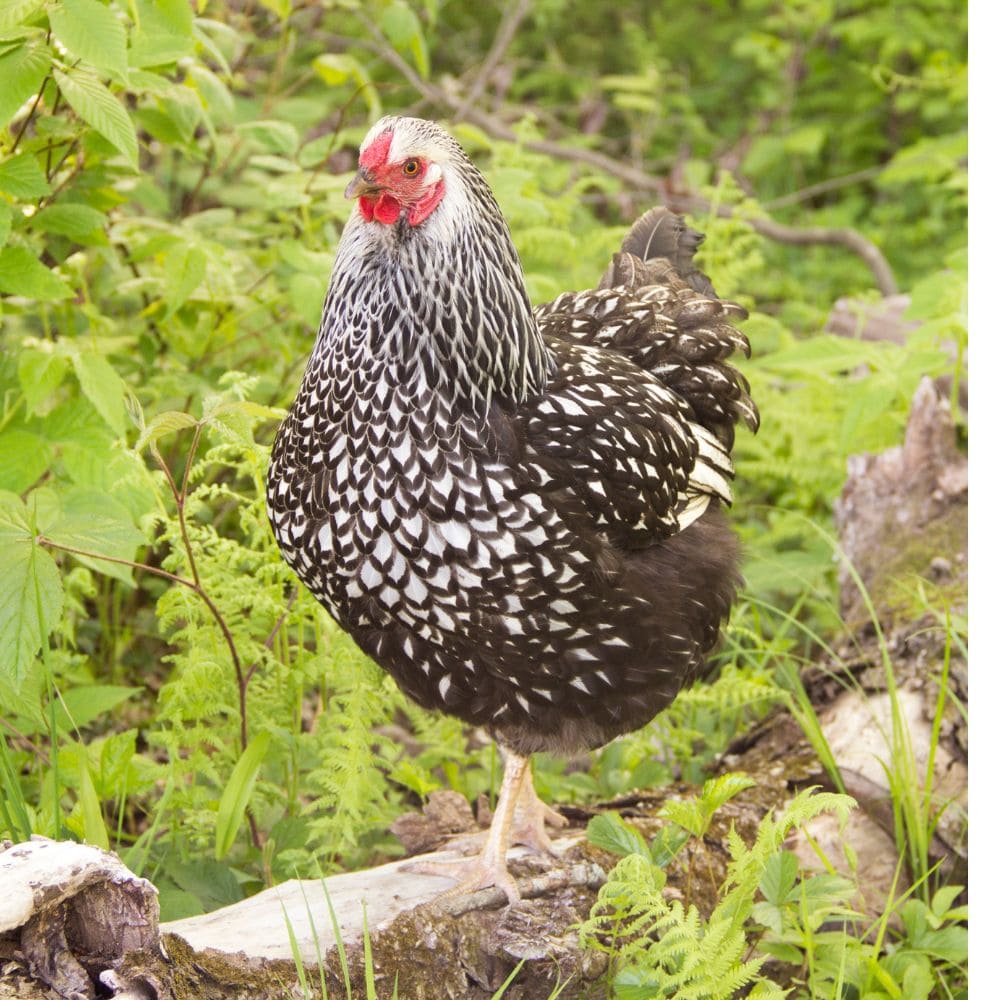
Are Wyandottes Cold Hardy?
Yes, they are! Because of their full, fluffy feathers, Wyandotte chickens do well in cold weather. This is because they can “fluff” their feathers, which provides a buffer between them and the cold. However, you need to make sure you feed your flock a solid diet based on a 16% protein layer feed.
They will also need a draft-free home that lets them stay warm and out of the elements.
Can Wyandotte Chickens Fly?
Wyandottes are moderate fliers, meaning they can fly up to a roosting bar, but aren’t likely to fly over tall fences. The hens especially prefer to stick close to their coops (and the roosters will stay wherever their hens are).
Are Wyandotte Chickens Noisy?
The roosters can be quite talkative, but the hens tend to be quiet and docile. You’ll probably notice your roosters being particularly noisy if there are predators around, or if it’s spring and they want to breed.
The hens are fairly low-key, and won’t bully each other too much – so you’re less likely to hear squawking out of them.
Different Wyandotte Varieties
What Does Silver Laced Or Golden Laced Mean?
“Silver Laced” and “Golden Laced” refers to the type of feathers on a Wyandotte – meaning, the feather is a solid color (such as gold) and edged in black. The effect makes the chicken’s feathers look like lace.
Silver Laced Wyandottes originated from crossing dark Brahmas with Silver Spangled Hamburgs – which gave them fuller, large bodies and the silver-laced feathers (you can see similar lacing on the adorable American Sebright chickens).
You can see similar lacing on the Partridge Wyandotte, although the Partridge feathers are much more intricate.
Golden Laced Wyandotte chickens were created by crossing silver-laced Wyandotte hens with gold-spangled Hamburg and partridge Cochin roosters, although the most influence can be seen from the contribution from the gold-spangled Hamburg roosters. You can read more about chicken genetics here.
What’s A Blue Laced Wyandotte?
Blue Laced Wyandotte chickens have that “gasp” factor because their feathers are so beautiful and unusual. Unlike the Silver Laced and Golden Laced varieties, the Blue Laced Wyandottes sport buff-colored feathers edged in blue instead of black.
The blue gene which gives the chickens their coloring is an incomplete dominant gene – so only some will have the blue lacing. In other words, this version of the Wyandotte chicken doesn’t breed true so you can get blue, black, or even a splash Wyandotte chicken.
However, when you do get the blue lacing alongside the buff, the contrasting colors give the chicken an other-worldly rainbow appearance.
Although not a recognized breed by the American Standard of Perfection, they do have a “Certificate of Development,” meaning they’re on their way to becoming recognized.
What’s A Buff Laced Wyandotte?
The buff-laced Wyandotte chicken has beautiful red feathers that appear edged in white. They’re the opposite of Golden Laced Wyandotte feathers! According to sources, the buff color comes from crossing two Blue Laced Red Wyandotte chickens.
Like the Blue Laced Wyandotte, the color of their feathers can differ from chicken to chicken, with some having a deeper buff color, and others having a lighter coloring that looks similar to Salmon Faverolles.
You might also notice that the heads vary from hen to hen, with some having white or cream-colored head feathers, and others sporting the buff color to their comb.
Do Wyandotte Chickens Come In Bantam Varieties?
Yes! Wyandotte chicken bantams are easily sourced at most hatcheries. You can find Silver Laced, Black, Partridge, Columbians, and Golden Laced bantams. Like their full-size counterparts, they lay brown eggs, although they don’t lay as frequently (3 times a week or so) and their eggs are smaller. However, they tend to be even friendlier than full-sized Wyandottes, which makes up for it!
Not all hatcheries carry all types of Wyandotte bantams, so it’s best to call and make sure your favorite seller hatches them.
What to Feed A Wyandotte Chicken
Like most chickens, Wyandottes need a particular diet to help them grow from day olds into healthy layers, and then lay great eggs for you.
If you feed them high protein feed with extra added nutrients, you will have fewer health issues in the long run.
Here’s what to feed your Wyandotte at every stage of her life:
Chicks
Chicks should have a high protein (at least 18% protein) chick starter. They need a lot of nutrients to grow correctly, and most commercial chick starters have everything they need. Click here to see a great chick starter that has all the right nutrients PLUS other great ingredients you won’t see in most feed.
You can also feed your Wyandotte chicks treats such as Chickeratti and Chicken Candy.
In the first week of their lives, I’ve started feeding my chicks both of these high protein treats – they’re irresistible, and I sleep better at night knowing they’ve got food in their bellies. Sometimes, due to shipping or general stress from being in a new place, they can skip dinner, which is bad news for a baby chick. The tasty treats are hard to resist, and even the most stressed chick usually sneaks some bites.
You should also provide water 24 hours a day in a mason jar waterer, or another waterer that is made for chicks. You can check out waterers here.
Layers
As previously said, layers should have a diet of layer feed that includes at least 16% protein. It’s best to not rely on free-ranging for 100% of your flock’s diet. Chickens tend to become flighty when they have to forage, and they might hide their eggs. You also can’t be sure all your hens are getting a square meal.
You can use an automatic feeder or simply a bowl – both work well. If you want an automatic feeder, you can read more about them here.
For Better Eggs
While a good layer feed should be top priority, you can also feed your flock:
- Calendula for golden yolks
- Garlic for overall health
- Oyster shells for extra thick eggshells
- Apple cider vinegar for gut pH balance (which also means healthier eggs. You can read more about apple cider vinegar here).
- Lemon Balm for overall wellness
- High protein goodies like Omega Burst
Waterers
Your waterer should hold enough water for your entire flock – if it doesn’t, you might want to consider more than one. It doesn’t matter whether your waterer is automatic, but it does make things easier.
The material also doesn’t matter, although, in the winter, a stainless steel one will freeze faster.
You can read about waterers here and if you want to build an automatic one yourself, I have a DIY waterer tutorial here that many chicken keepers have utilized.
The Best Coop For A Wyandotte Chicken
While most any shelter will work as a home for your flock, Wyandotte chickens tend to be on the smaller side (especially if you have bantams), and like all chickens, their defenses are limited. So, it’s important to make sure they have a safe coop to sleep in each night.
In particular, your coop should:
- Be predator-proof (learn how to build a predator-proof coop here)
- Have 10 ft of square space per chicken
- Be safe for chicks
- Have plenty of ventilation for summer and winter. (Learn how to install a window here).
For your coop to be safe for chicks, it must be 100% predator-proof (even rats will attack chicks) so that no predator can get into the living area. An automatic coop door is a good idea.
Bear in mind that chicks don’t roost until they’re at least 8 weeks old (and sometimes, it takes longer), so they’ll spend their nights sleeping on the ground. There’s a possibility a predator could easily eat them, or they might get trampled by the other chickens. Having a separate area for your chicks is a good idea.
Nesting Boxes For Wyandotte Chickens
Your Wyandottes will also need a nesting box or two. It’s best to have 1 box for every 5 hens. You can make them or buy commercial ones – both are perfectly fine. Just make sure it’s easy to clean, and you can remove shavings or other bedding without difficulty.
You can read more about nesting boxes here to get a good idea of what’ll work best for your coop. Be sure to clean it weekly, and remove all eggs daily.
How to Protect Wyandotte Chickens from Predators
To protect your Wyandottes from predators, your first line of defense is your coop. It should be predator-proof, and it’s best to also have a run (instead of free-ranging). You can learn about the different types of chicken wire here. Hardware cloth is the safest, but it’s also the most expensive – in some cases, the chicken wire might be a better option (it’s what we use.)
You can also use motion sensors to trigger lights around your coop. Since most predators like raccoons don’t like sudden light, it can deter them.
One predator to watch out for are domestic dogs. While they won’t hurt your chickens because they’re hungry, they might hunt them for sport. To keep your chickens safe, make sure their coop and run is dog proof. If dogs keep bothering your chickens, you might want to put a fence around your property.
The nice thing is that Wyandottes seem to be pretty happy in confinement.
The Best Hatcheries To Buy Wyandotte Chickens
Below are some of the best hatcheries to buy Wyandottes from. You can also check with local breeders in your area.
1. Meyer Hatchery
Location: Polk, OH
Find more information and prices here: Meyer Hatchery
There are actually two Meyer Hatcheries in the United States – while one is located in Pennsylvania (and spelled “Myers”), the other is located in Polk, OH. They both offer exceptional deals on baby chicks, but Meyer Hatchery in Ohio is one of the best places to buy Wyandotte chicks, hens, and roosters alike.
Here, you’ll find all kinds of Wyandotte chicks for sale, including Black Laced, Silver Laced, Blue Laced, and Columbian Wyandottes.
Meyer Hatchery has a minimum order of only three chicks and you can order at just about any time of the year. There’s on-site delivery as well as other products for sale, like books and coops. You can even buy fertile-hatching eggs!
Advantages
- Small minimum chick order
- Fertile hatching eggs available
- Discounts for buying large flocks
Disadvantages
- Chicks don’t always meet breed standards for exhibition purposes
2. Cackle Hatchery
Location: Lebanon, MO
Find more information and prices here: Cackle Hatchery
Cackle Hatchery is not a small chick hatchery by any means. In fact, at Cackle, you’ll find well over 185 different kinds of chickens at all stages, including fertile hatching eggs, baby chicks, and pullets, too. The hatchery sells a variety of rare breeds, bantams, and other game species, too.
They have a wonderful 3 chicks minimum. Cackle offers several kinds of Wyandotte birds for you to choose from, including Black-Laced Golden, Columbian, and Splash laced Red.
Advantages
- Can reserve birds ahead of time
- Vaccinations available
- Discounts for male chicks
Disadvantages
- Birds only shipped seasonally
3. Murray McMurray Hatchery
Location: Webster City, IA
Find more information and prices here: Murray McMurray Hatchery
Shop for chicks with Murray McMurray, and you’re sure to find anything and everything you might be looking for. Located in Webster City, IA, this breeder sells sexed, male, and female Wyandotte chicks.
There are several colors available, including Blue Laced Red, and Columbian. You can order just one or two chicks (with some restrictions) or you can buy as many as 100 or more. It’s important to note that female and straight-run chickens sell out more quickly with this hatchery, but the beauty of ordering with Murray McMurray is that you can specify your order date well ahead of time.
You will need to order a minimum of fifteen chickens (although some chicks, when purchased at Murray McMurray, can be bought in small batches of six birds). If you order before April 1st, you must order 25 chicks to help your birds stay warm. You can always mix and match your flock, too!
Don’t forget to stock up on all the things you need to prepare your chicks for the exciting days ahead, either. A good chick starter like this one is essential!
Advantages
- Mix-and-match options available for all breeds
- Multiple kinds of Wyandotte chickens available
- Discounts for bulk orders
Disadvantages
- Must order 25 chicks when buying in the winter
4. California Hatchery
Location: Walnut Creek, CA
Find more information and prices here: California Hatchery
You’ll find all kinds of Wyandotte chicks when you shop with California Hatchery, including Gold-Laced, Silver-Laced, and White. These chicks are some of California Hatchery’s most popular.
You can buy male, female, or straight-run chickens when you shop with California Hatchery, with noticeable pricing differences between all three options. If you’re willing to pay a few extra dollars per bird, you can get a Marek’s vaccination, too – something that’s valuable for many people.
California Hatchery ships just about everywhere in the United States. You’ll get a safe arrival guarantee with your order, too, so you don’t have to worry about something going wrong with your chicks.
One more tip to prevent problems with your chicks? Take care of the coop. Regular cleaning and adding nesting herbs, like these for dust baths, is extremely helpful when it comes to preventing lice and mites.
Advantages
- All chicks backed by safe arrival guarantee
- California Hatchery raises exhibition-quality stock
- Several types of Wyandottes available
Disadvantages
- Costly per-chick price
5. Chickens for Backyards
Location: Phillipsburg, MO
Find more information and prices here: Chickens for Backyards
Chickens for Backyards, located in Phillipsburg, MO, offers some of the best chicks and the highest level of customer service, too. Here, you’ll find all kinds of chicks along with pullets and cockerels, too.
The company is known for its superior communication. When you order, you’ll receive an estimated hatch date within just half an hour of submitting an order. The date is so accurate that your chicks will usually arrive within a day or two after that estimated hatch date.
This is great because you can be guaranteed that your chicks will arrive safely and healthy. You don’t have to worry about them dying in transit, as they are shipped so close to their hatch date.
Chickens for Backyards sells all kinds of Wyandotte chickens, including Black-Laced Red, Silver-Laced, Golden-Laced, Blue-Layed, and even Black Wyandotte bantams.
Advantages
- Large variety of Wyandotte breeds
- Superior customer service
- High survival rate of baby chicks
Disadvantages
- Shipping fees are not included
Maat van Uitert is a backyard chicken and sustainable living expert. She is also the author of Chickens: Naturally Raising A Sustainable Flock, which was a best seller in it’s Amazon category. Maat has been featured on NBC, CBS, AOL Finance, Community Chickens, the Huffington Post, Chickens magazine, Backyard Poultry, and Countryside Magazine. She lives on her farm in Southeast Missouri with her husband, two children, and about a million chickens and ducks. You can follow Maat on Facebook here and Instagram here.

